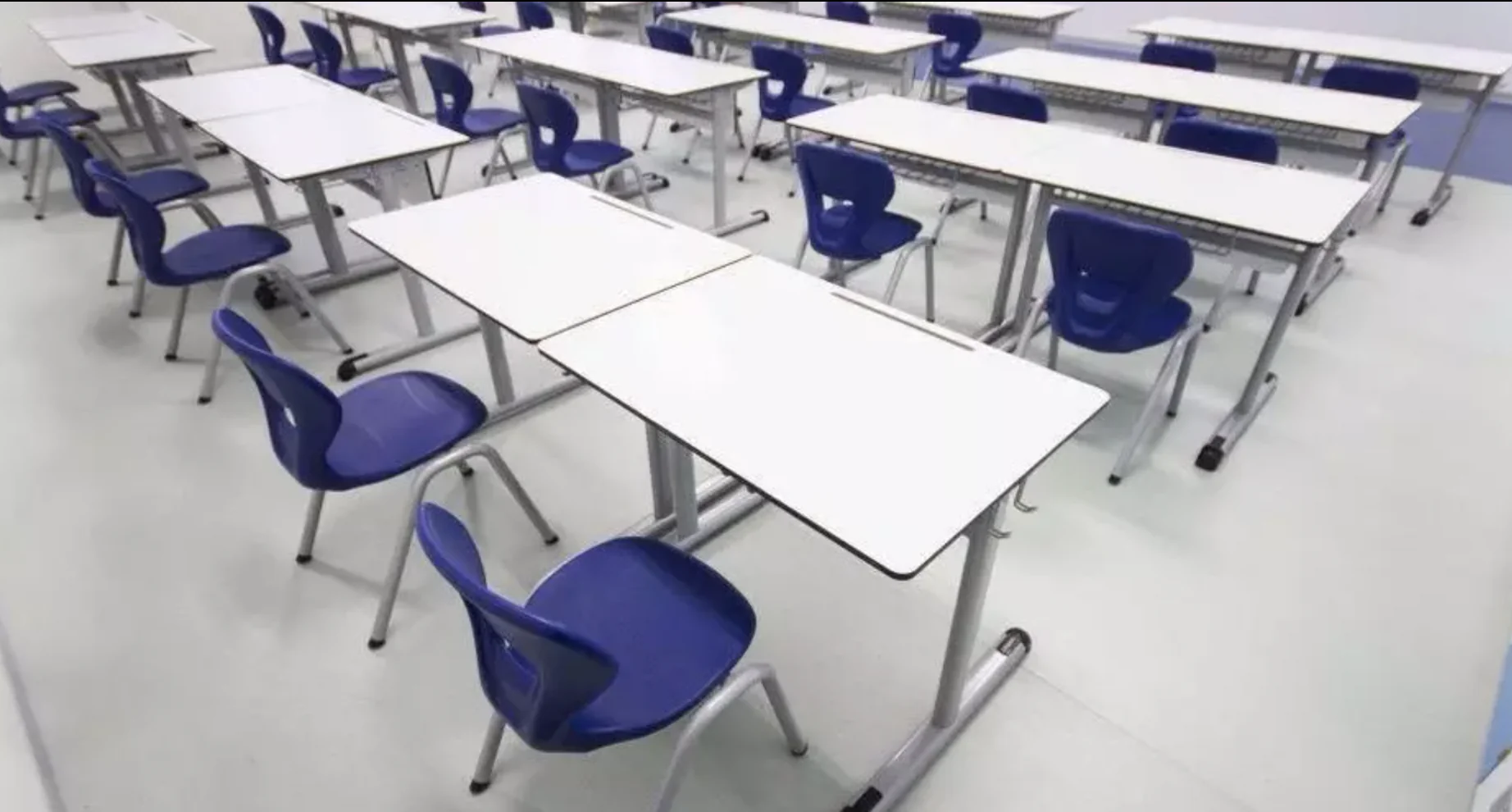School Furniture Manufacturer; Did you know the average student will spend over 15,000 hours sitting in classroom desks and chairs by the time they graduate high school? With students spending so much time using school furniture, it’s critical that these pieces properly support growing bodies while withstanding years of daily use.
As a top manufacturer of school furniture for over 50 years, we understand the importance of designing desks, chairs, tables, and other equipment to be comfortable, safe, durable, and adaptable to the evolving needs of students and teachers. In this blog post, we’ll explore key considerations when selecting high-quality furniture for educational settings. Whether you’re an administrator outfitting a new school or a parent advocating for your child, we hope this overview of factors like ergonomics, flexibility, technology integration, and more will help guide your school furniture decisions. Quality furniture optimizes the learning environment, and our decades of expertise position us to be your ideal partner. Let’s examine how the right furnishings can benefit students for years to come.
Brief History of School Furniture
For centuries, students simply sat on benches or stools to learn. It wasn’t until the late 1800s that actual school desks emerged, often made of cast iron with wooden desktops. These early school desks were heavy, rigid, and impractical by today’s standards.
By the early 1900s, steel and wood frames became more common, allowing for adjustable seat heights and more mobility. After World War II, design focused on mass production of inexpensive and lightweight furniture from materials like plastic and plywood.
More recently, ergonomics, flexibility, and technology integration have shaped modern school furniture. Desks have become more adaptable, with adjustable tabletops, movable seats, and modular components. Materials like polymer and composites are now used to make furniture lighter while retaining sturdiness.
While school furniture today looks quite different from centuries past, the goal remains the same – keeping students engaged and learning in an effective environment. Advances continue to be made, ensuring school furniture adapts to new teaching methods and the needs of students.
Ergonomics and Design
Proper ergonomics is crucial for students’ health and effective learning. School furniture that is not ergonomically designed can lead to back, neck, and joint pain, injuries, and long term damage. It can also make students uncomfortable and fidgety, hampering their ability to focus during long school days.
That’s why innovations in school chair and desk design have focused heavily on proper ergonomics. Chairs are now engineered to provide lumbar support, promote good posture, and keep students attentive. Desks and tables allow for adjustable heights and angles to fit growing bodies. New materials like breathable mesh improve airflow and comfort.
Many modern school desks and chairs also have wiggle room built in, so students can fidget without distracting others. This stimulates blood flow and energy, keeping students engaged in learning. Movement is no longer seen as a distraction but an important part of the learning process.
Ergonomic school furniture is shaped by research into children’s physiology and how they learn best. The result is classroom environments tailored to keep students comfortable, focused, and healthy.
Durability and Safety
When selecting school furniture, durability and safety should be top priorities. School furniture must withstand years of regular use and potential misuse from students. Desks and chairs should be made of durable materials that can hold up to wear and tear without breaking or becoming hazardous. At the same time, the furniture must meet safety standards to ensure no sharp edges, toxic materials, or other risks that could harm students.
Specifically, school furniture manufacturers should choose sturdy materials like hardwoods, metals, and high-density plastics that can endure scrapes, scratches, and impacts. Joints and hinges should be reinforced for strength. Upholstery and cushions should consist of rip-proof, stain-resistant fabrics.
It’s also critical that all school furniture passes safety certifications like ASTM, BIFMA, or ANSI standards. This validates that the furniture has been tested for stability, durability, and hazard-free designs. Locking mechanisms, articulating joints, and adjustable features should be designed to minimize pinch points or entrapment risks. Besides physical safety, furniture should also be tested for chemical safety by checking for dangerous substances like lead or phthalates.
Ultimately, high-quality school furniture should be built to last through generations of students while protecting their safety. Prioritizing durable yet hazard-free materials and constructions ensures the furniture remains in excellent condition and avoids damage or injuries. This provides the best value by reducing replacement costs and liability risks for schools over the long term.
School Furniture Manufacturer Flexibility and Versatility
School furniture needs to be adaptable to suit different teaching styles and classroom arrangements. With evolving pedagogies and learning approaches, flexibility is key. Furniture should allow students and teachers to easily rearrange their space and configure it in different ways, rather than being rigid and fixed. This enables collaboration, group work, experiential learning and student-centered activities.
Multi-use furniture is ideal for maximizing flexibility. For example, a mobile desk or table that can be folded, stacked or joined together with others allows for seamless switching between individual work, small group activities and whole class discussions. Lightweight chairs that stack can also be moved around and rearranged with ease.
Storage furniture, such as mobile cabinets, provide versatile spaces to store equipment and resources that students can access. They bring an element of flexibility as they can be transported around the classroom or between classrooms as needed.
With flexible, multi-use furniture, classrooms can quickly and easily transform from a traditional lecture format to group work to interactive demonstrations. This supports emerging teaching methodologies and caters to different learning styles. Ultimately, it empowers teachers and students to shape the learning environment in creative ways.
School Furniture Manufacturer Cost Considerations
School furniture is a major investment for any educational institution. With tight budgets and limited resources, educators need to maximize value while meeting the needs of students, teachers, and staff. When evaluating school furniture, be sure to consider the following factors related to cost:
Evaluate Long-Term Value Over Initial Price
The initial purchase price is not the only cost to consider. High-quality commercial grade furniture made with durable materials will last longer and require less maintenance and replacement over time. Going with the cheapest options may end up costing more in the long run. Focus on total cost of ownership rather than just upfront costs.
Prioritize Flexibility and Adaptability
Look for versatile, flexible furniture that can be rearranged and adapted to changing needs. With mobile desks and stackable chairs, for example, classrooms can be easily reconfigured for different activities and evolving pedagogies. Flexible, multi-use furniture extends usefulness over time.
Factor in Volume Discounts
Most school furniture companies offer significant discounts for bulk orders. Buying in scale across multiple classrooms, grades or schools allows for cost savings through volume pricing. Consider collaborating and combining orders to maximize leverage.
Compare Warranties and Replacement Parts
Quality commercial furniture comes with generous warranties of 10 years or more. Replacement parts should be readily available at reasonable costs. Factor in warranty coverage and replacement part expenses when comparing options.
Prioritize Ergonomics
Ergonomic furniture designed for proper posture and movement helps create a healthy learning environment. This avoids long-term costs associated with injury or discomfort. While more expensive upfront, the long-term benefits are substantial.
Consider Multiple Functions
Look for furniture that serves multiple purposes, such as desks with built-in storage cubbies or chairs that stack for easy storage. Multi-use furniture effectively provides more value for the cost.
Evaluate Energy Efficiency
Energy-efficient options like LED lights, occupancy sensors and daylight harvesting systems may cost more initially but deliver significant long-term energy savings.
By focusing on total cost over time rather than just initial price, schools can invest wisely in quality, durable furniture that effectively supports students’ learning needs for years to come.
Maintenance and Longevity
A key consideration for school furniture is how much maintenance it will require and how long it will last with proper care. Schools need furniture that is built to withstand heavy daily use from students while requiring little upkeep from staff.
When evaluating furniture options, look for pieces made from durable materials like hardwoods, steel, and high-density plastics that can handle scratches, stains, and cleaning chemicals without degrading over time. Avoid furniture with many nooks and crannies that could trap dirt and debris.
Also examine how easily different chairs, desks, and tables can be cleaned. Pieces with smooth, non-porous surfaces allow for quick wiping or dusting between classes. Being able to sanitize furniture is particularly important for maintaining hygienic classrooms and cafeterias.
Proper care is also essential for maximizing a furniture’s lifespan. Follow all manufacturer instructions for cleaning products and techniques. Periodically inspect for damage or wear and perform minor repairs. Replacing glides, tightening joints, or touching up paint can go a long way towards keeping furniture functional.
With quality construction and materials plus routine maintenance, school furniture can last for decades rather than needing replacement every few years. This saves schools money while providing consistent learning environments for students.
Environmental Sustainability
Schools today are increasingly focused on reducing their environmental footprint and instilling sustainable values in students. As major purchasers of furniture, schools have significant power to drive sustainability in this industry. Furniture manufacturers can support these efforts in several key ways:
-
Eco-Friendly Materials: Furniture made from renewable and recycled materials has a lower carbon footprint. Wood and metal certified by environmental organizations ensures sustainability. Using wool, cotton and other natural fabrics reduces plastic waste.
-
Green Manufacturing: Energy-efficient and low-emission production processes reduce environmental impact. Some manufacturers use solar, wind or geothermal energy. Others recycle production waste into raw materials. Local sourcing further cuts transportation pollution.
-
Recycled and Upcycled Furniture: Refurbishing and reusing existing school furniture is an economical sustainability solution. Some manufacturers also upcycle other materials like plastic bottles or surplus fabrics into furniture. Giving used furnishings a second life saves resources and diverts waste.
-
Take-Back Programs: Responsible manufacturers assist schools in recycling old furniture and safely disposing hazardous materials. They reuse salvageable components and ensure hazardous parts are disposed ethically. This prevents waste from burdening landfills.
-
LEED Certification: Leadership in Energy and Environmental Design (LEED) provides a rating system for sustainable construction and interiors. Manufacturers who are LEED-certified produce furnishings that can help schools achieve LEED status through environmentally-sound materials and practices.
By partnering with responsible manufacturers, schools can reduce waste, toxins and their carbon footprint. Eco-friendly furnishings educate students and provide healthy, sustainable learning environments.
School Furniture Manufacturer Technology Integration
Classrooms today need furniture that can accommodate computers, tablets, and other technology that is essential for learning. Students need desks and tables with built-in power outlets and cord management to keep devices charged without creating tripping hazards from a tangle of cords on the floor. Furniture manufacturers offer a range of solutions:
-
Individual student desks and tables with outlets, USB charging ports, and cord clips built into the work surface so students can plug in their devices.
-
Modular tables that can be configured with power grommets and concealed cord channels. These allow cables to be run neatly through the legs or modesty panels underneath the table.
-
Mobile carts, workstations on casters, and flexible “node” seating that can be easily rearranged and provide both seating and powered surfaces for small group collaboration.
-
Height adjustable desks and tables that allow standing or sitting use, promoting ergonomic posture for tech devices.
-
Storage furniture like shelving units, lockers, and cabinetry to store, charge, and secure tablets, laptops, and other classroom technology when not in use.
-
Whiteboards and tackboards with integrated power outlets or cable trays for mounting TV monitors, projectors, and other AV equipment.
The key is flexibility and adaptability. Furniture that incorporates power and cord management allows classrooms to evolve along with educational technology. This infrastructure ensures students have equal access to charge devices and seamlessly use technology for learning.
Conclusion
School furniture serves a critical role in education and continues to evolve to meet the changing needs of students, teachers, and learning environments. As we have explored, key considerations in school furniture include ergonomics, flexibility, technology integration, sustainability, safety, cost, and maintenance.
Quality school furniture directly impacts the health, engagement, and academic achievement of students. Well-designed desks, chairs, and collaborative spaces support proper posture, comfort, and focus during long school days. Versatile, movable furniture enables active learning and differentiated instruction. Technology-enabled tables allow seamless integration of devices for digital work. Environmentally-friendly materials reduce schools’ carbon footprint. Durable furnishings withstand heavy use and keep students protected. Affordable options make furniture accessible for every budget. With routine care, school furniture lasts for years of use.
Looking ahead, we can expect further advances in school furniture. Makers will continue improving ergonomic designs to promote movement and comfort. More modular, flexible pieces will allow reconfiguration for evolving learning activities. Seamless power and tech integration will enable digital workspaces. Sustainable materials like cork, bamboo, and recycled plastics will gain popularity. Cost-effective solutions will emerge to provide quality furniture to all.
Ultimately, school furniture has an enormous impact on the educational environment. Well-designed pieces directly enable better teaching and learning outcomes. As designers continue innovating school furniture, they will shape the future of education for generations of students to come.









